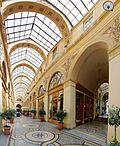
The covered passages of Paris (French : Passages couverts de Paris) are an early form of shopping arcade built in Paris, France, primarily during the first half of the 19th century. By 1867, there were approximately 183 [1] covered passages in Paris but many were demolished during Haussmann's renovation of Paris. Only 25 survived into the 21st century, all but one are in the arrondissements (municipal districts) on the Right Bank of the Seine.
Contents
The common characteristics of the covered passages is that they link at least two streets, have glass ceilings and are pedestrianised, artificially illuminated at night (initially with gas lamps), privately owned, highly ornamented and decorated, and lined with small shops on the ground floor. The passages’ upper floors usually had apartments. [2] Originally, to keep the passages clean, each would have at the entrance an artiste de décrottage (a ‘shoe cleaning artist’).
From a cultural standpoint, the passages have served as centers of social interaction: Alfred de Musset frequented the Galerie Vérot-Dodat when visiting a famous actress. [2] Eugène-Francois Vidocq, the father of criminology and of the French police system, lived in the Galerie Vivienne in 1840. [2] As a child, Louis-Ferdinand Céline lived in the Passage Choiseul. [2] The passages were the subject of Walter Benjamin's incomplete magnum-opus Das Passagen-Werk (Arcades Project) which was posthumously published.
They should be distinguished from other Parisian roads also called passages but whose route runs in the open air.
























